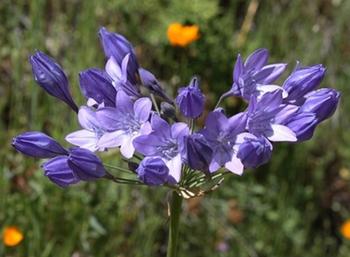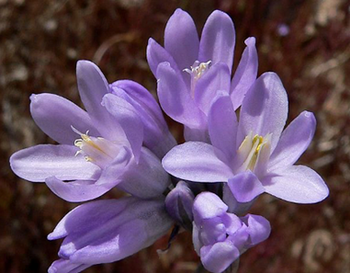Fall 2023
Native California bulbs for your garden

Fall is upon us, which means it’s almost time to plant spring-blooming bulbs. How about native California bulbs? There are hundreds to choose from, many boasting glorious colors and breathtaking shapes. Native bulbs add a unique California feel to your garden. They bloom longer than their cultivated cousins and they attract birds, bees, and butterflies. Because they’re native, they are naturally adapted to Marin’s most common cultural conditions: wet winters and dry summers. Many even thrive in our heavy clay soils. The best part? They’re easy! Just pop them in the ground in fall and look forward to the show every spring.
Native bulbs 101
If you’ve had the pleasure of seeing wildflowers in bloom while hiking a Marin trail, you know how enticing they can be. California’s bulbs are also a part of our state history. The corms of blue dicks (Dipterostemon capitatus), for example, have been used as food for more than 10,000 years. Some bulbs are endemic, meaning they only grow in certain areas. For instance, the Tiburon mariposa lily (Calochortus tiburonensis) only grows on Ring Mountain in Corte Madera. Allium munzii and many more native bulbs are on the federal list of endangered species. Native bulb preservation and propagation help keep California beautiful.
Bulbs are geophytes
Bulbs are geophytes — plants with underground storage structures that accumulate water and nutrients. These storage systems help them survive dormant (dry) periods and nourish them during the flowering and growing seasons. Depending on the type of storage structure, bulbs are classified as true bulbs (Allium, Fritillaria,), corms (Brodiaea, Erythronium), or rhizomes (Calochortus, Iris). Bulbs, corms, and rhizomes are monocots, which means they produce a single leaf on the first shoot and have flower parts in threes, or multiples of threes.
Finding the right bulb
Gardening with native bulbs is easy as they grow in most California ecosystems. They will thrive and provide year after year of bloom if cultural conditions in your garden match or closely resemble those of their natural habitats. Most prefer full sun or part shade and some even prefer heavy clay soils. They do not tolerate extensively cultivated beds and do not grow in potting soil. Plant bulbs in the fall after the first rain. Do not water them in summer; they will rot if watered during their dormancy. Protect bulbs from slugs, gophers, rabbits, deer, and other uninvited garden visitors.
Native bulbs in Marin
Some native bulbs are easier to grow than others. Allium, Brodiaea, and Iris are especially easy. They are naturalized in Marin, meaning they multiply every year. There are almost 50 species of native California Alliums, or wild onions, and several grow in Marin. Pacific Coast Brodiaeas include two Marin natives: blue dicks (Dipterostemon capitatus) and Ithuriel’s spear (Triteleia laxa). Other Marin natives include the beautiful pacific coast irises (Iris douglasiana and Iris macrosiphon), the latter endemic to California, and specifically to the San Francisco Bay Area.



Where to buy native bulbs
It can be difficult to find native bulbs at retail nurseries, but some mail-order nurseries specialize in these plants. Look online for the Theodore Payne Foundation, Telos Rare Bulbs, and North Coast CNPS nursery.
Learn more
Check out Calscape and the Pacific Bulb Society for more information on native bulbs. For information on choosing and growing bulbs, visit the UC Marin Master Gardener bulb page.
Let’s plant California native bulbs this fall and brighten our gardens for years to come!
